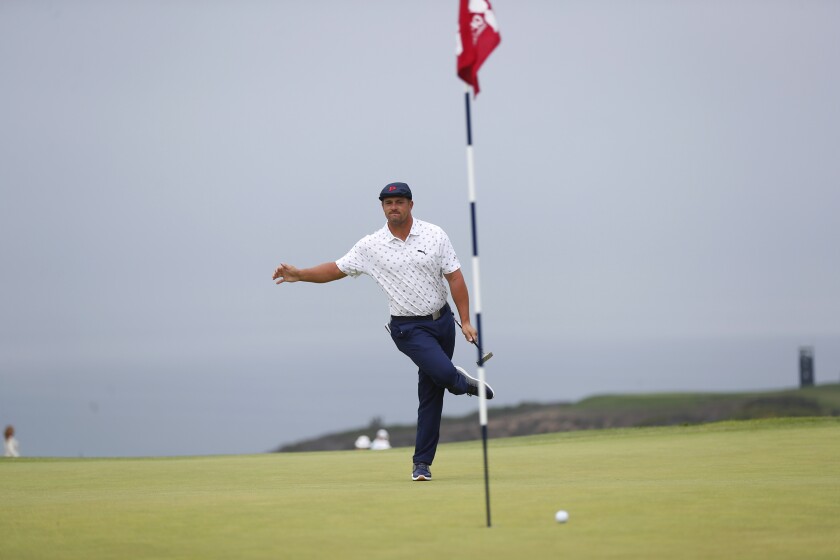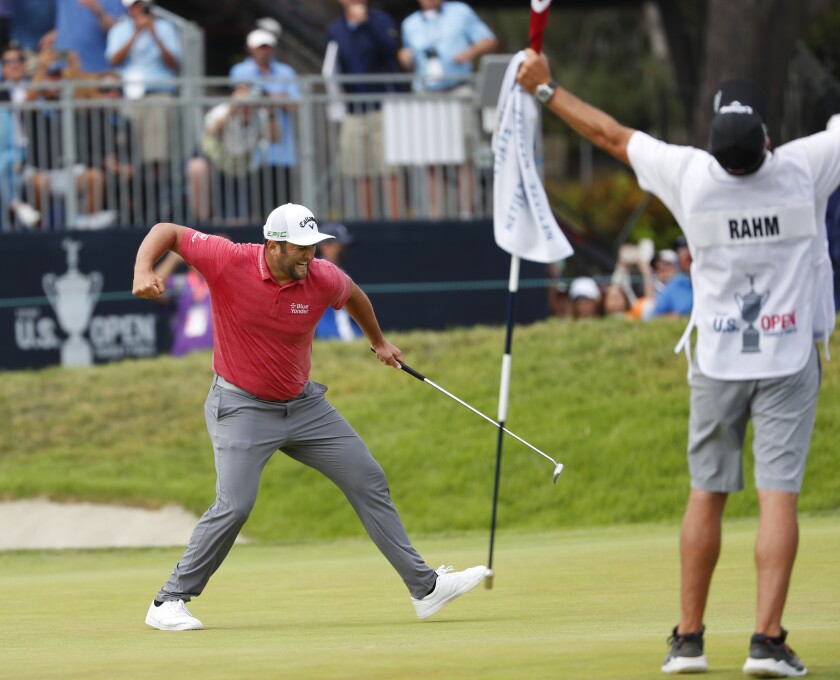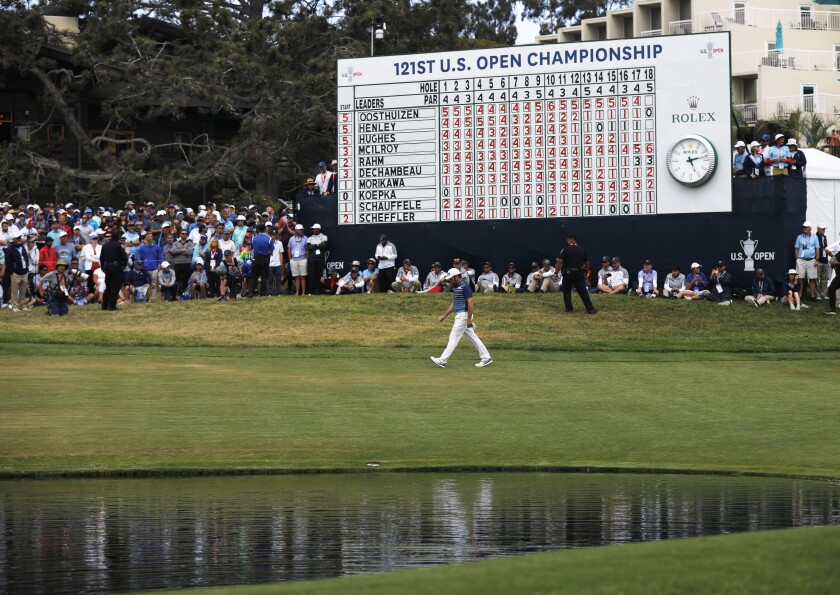The 121st U.S. Open at Torrey Pines’ South Course in La Jolla was decided June 20 on the par-4, 434-yard 17th hole.
Jon Rahm birdied it and won. Louis Oosthuizen bogeyed it a half-hour later and lost by a stroke.
But really, it was decided years earlier, when high winds and the dreaded Japanese beetle and old age took their toll on the course’s namesake trees perched on the edge of the canyon bordering the left side of the fairway. They were still standing when golf course designer Rees Jones embarked on his 2001 facelift of Torrey South for the 2008 U.S. Open. They were gone when he tweaked it again in 2018 ahead of the U.S. Open’s return this year.
The plan in 2001 was to use the canyons as natural hazards on as many holes as possible, building new tees, shifting fairways, relocating greens on the third, fourth and 14th holes. The trees prevented that at 17. The Torrey pine, which grows only here and on the Channel Islands off the coast of Santa Barbara, is listed as a critically endangered species.
“But they were lost naturally over the years,” Jones said, “so it enabled us to move the fairway closer to the canyon at 17 than we could 20 years ago.”

Bryson DeChambeau watches his putt on the 17th hole during the second round of the U.S. Open at Torrey Pines Golf Course in La Jolla on June 18.
(K.C. Alfred / The San Diego Union-Tribune)
Jones — aka the “Open doctor” — was speaking the day after a scintillating final round with a leaderboard jammed with golf’s biggest names. He was like an artist marveling at his creation, a father proud of his offspring. He winced when Oosthiuzen’s drive on 17 kicked left into the canyon. He also allowed himself a knowing smile.
“I felt bad for him because he’s such a nice person,” Jones said. “But by the same token, I was glad that the redesign of the 17th hole was really the determining factor of the championship. That change we made, it made a big difference.”
Jones shifted the fairway toward the canyon rim, with little rough or foliage to stop a golf ball from bounding into the barranca. He narrowed it where most drives land and reconfigured the bunkers on the right. He built an alternate tee lower and to the left of the original one, creating a different angle to the fairway and bringing the hazard more into play.
What does risk-reward look like in statistics? The 17th hole yielded the most birdies (52) of any par 4 on the back nine but was No. 1 on the course in penalty strokes off the tee.
The idea is to make you think. Play it safe to the right, you’re in sand or rough but have a relatively good shot at par. Aim left, you have a better shot at birdie but you flirt with the rattlesnakes.
Rahm went to 17 trailing Oosthuizen, who was playing three groups behind him, by one. He aimed his tee shot safely right and landed in the fairway bunker, got it on the green 25 feet left of the hole and made a left-to-right breaker for birdie.

Jon Rahm celebrates with caddie Adam Hayes after sinking a birdie putt on the 18th hole as he won the U.S. Open at Torrey Pines Golf Course on June 20.
(K.C. Alfred / The San Diego Union-Tribune)
Rahm also birdied the par-5 18th, statistically the easiest hole on the course, and led by a stroke when Oosthuizen pulled out his driver on 17. He took a brave line down the left side.
“A lot of players would intentionally go for the bunker off the tee,” Jones said. “I think he wanted to have an easier shot in and took that chance. If he’d been ahead, he probably would have done the same thing that Rahm did. But that’s what makes Torrey Pines such a great place to play, visually and in terms of demands. The canyons are very much a part of the round.”

Louis Oosthuizen, who finished second in the U.S. Open, walks toward the 18th green during the final round at La Jolla’s Torrey Pines Golf Course on June 20.
(K.C. Alfred / The San Diego Union-Tribune)
Oosthuizen’s ball bounced twice, kicked left and disappeared into a bush. He took a penalty drop, hit a wedge to 10 feet and missed the par putt.
“Pulled it by five yards,” the South African said of his drive. “Standing on that tee again, I’d probably do the same thing. I went for it, and that’s what you have to do to win majors. Sometimes it goes your way and other times it doesn’t.”
Jones is biased, of course, but he said he doesn’t understand the whispers that the U.S. Golf Association wants to move away from municipal courses for its flagship event and settle into a rotation of classic, private venues such as Oakmont, Winged Foot and Pinehurst.
“That was before the event,” Jones said. “This was a home run for everybody.”
The USGA has named U.S. Open hosts through 2027, plus Pinehurst No. 2 in North Carolina in 2029, 2035, 2041 and 2047 as part of a deal to add a museum, research facility and satellite office on the property. There are two West Coast stops on the horizon (which TV likes because they air in prime time on the East Coast): 2023 at Los Angeles Country Club and 2027 at Pebble Beach.
“I think the USGA was over-the-top happy and I think it’s now a classic golf course,” said Jones, who correctly predicted the winning score this year would be 5 or 6 under par. “I think it will come back, yes. The demands are such that it’s not overwhelming but the cream rises to the top. Now Rahm is the No. 1-ranked player in the world [after his win], and obviously Tiger [Woods] was No. 1 in 2008.
“They crowned the proper champion both times, and that’s sort of what they want.”
You won’t get much argument from the players, who raved about the setup. “Fair” was a popular word when describing it.
The average score was 73.451, compared with 73.341 in January on the South Course for the Farmers Insurance Open and 74.725 in 2008.
Only champion Bryson DeChambeau was under par in the 2020 U.S. Open in September at Winged Foot in Mamaroneck, N.Y. Only Woods and Rocco Mediate were in 2008.
Twelve were this year.
Phil Mickelson, who has been outspoken in his criticism of U.S. Open setups in the past, had high praise for Torrey Pines despite finishing tied for 62nd at 11 over par.
“In the 30 years that I’ve played the U.S. Open, this is the best I’ve seen,” Mickelson said. “I thought they did a remarkable job, and I’m really proud and happy that it’s here at Torrey. … You have guys who are long hitters, guys who are short hitters, a lot of different strategies, and it comes down to execution. It hasn’t limited [anybody]. Everybody’s had a chance if they play well.”
At one point in the final round, there was a four-way tie for first at 4 under and a six-way tie for second at 3 under. That included seven players in the top 20 of the world golf rankings.
“I love this golf course, it’s fun to play,” said two-time U.S. Open champion Brooks Koepka, who finished tied for fourth. “I think it’s perfect for a major championship. The way it sets up, you’ve got to be able to put the ball in the fairway, control your irons and you’ve really got to putt well out here. That’s kind of the basis of a major championship. You need to be able to do everything really well. I think this course is perfect for that.”
England’s Paul Casey, who tied for seventh, said: “As a golf course setup, it was brilliant, and I haven’t always been able to say that in the past. Torrey Pines was a superstar. You can still set it up badly if you’re not careful, and they didn’t. It was a great championship. So, well done to the USGA.” ◆
"course" - Google News
June 24, 2021 at 05:03AM
https://ift.tt/3h4ptpL
La Jolla's Torrey Pines Golf Course gets rave reviews from U.S. Open players and 'Open doctor' - La Jolla Light
"course" - Google News
https://ift.tt/35q9ps5
https://ift.tt/35rCFi1
Bagikan Berita Ini














0 Response to "La Jolla's Torrey Pines Golf Course gets rave reviews from U.S. Open players and 'Open doctor' - La Jolla Light"
Post a Comment